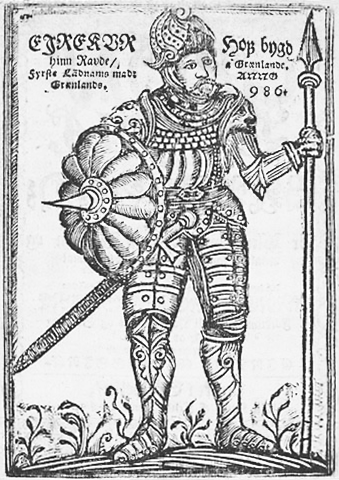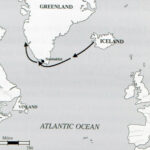Erik the Red
Explorer
Medieval
Quick Facts:
Erik the Red was the first European to land on and settle in Greenland.
Introduction
Erik the Red was a Norwegian Viking known for discovering and colonizing Greenland. His red hair and beard – which matched his hot tempered personality – earned him the nickname “Erik the Red.” He often clashed with his neighbors, and was even banished from both Norway, and then Iceland, before becoming the first known permanent European settler in Greenland.
Biography
Early Life
Erik Thorvaldsson was born in Rogaland, Norway in 950 CE. He was the son of Thorvald Asvaldson (also spelled Osvaldson). He would later become known as Erik the Red because of his red hair and beard. Around the age of ten, Erik left with his father who was exiled from Norway after he killed someone, and they settled in a place called Dranga, Iceland. Early Norseman had settled in Iceland around 860 CE. By the time Erik arrived almost a hundred years later, much of the land was already claimed.1 After his father’s death, Erik married a woman named Thorhild who came from a wealthy family, and he inherited a large farm north of Dranga. There he cleared land and built a home he named Erikstad after himself.2 In 970 CE, he had a son, Leif Eriksson, who would also become a famous explorer.
Around 982 CE, some of Erik’s servants accidentally caused a landslide that destroyed his neighbor’s house. His neighbor killed Erik’s servants, and in revenge, Erik killed his neighbor. He moved to another settlement on the two small islands Oxney and Sudrey. While living here, he once again found trouble with his new neighbor. Several people, including the two sons of Erik’s neighbor, were killed. Erik went on trial, was found guilty of murder, and once again banished from his home.3 Since he could not return to Norway, he instead decided to explore new land to the west he had heard about. In 877, an Icelandic settler named Gunnbiorn Ulfsson (also spelled Gunnbjorn) was driven by a storm to the coast of present day Greenland. He did not land there, but instead continued on his journey. Erik the Red decided to go in search for this land and further explore it. He left Iceland and headed westward.4
Voyages
Principal Voyage
Erik’s voyage began in the spring of 982. He and his ships left from Sneefellsjokull (spelled Snaefellsjokull in Icelandic) and traveled about 180 miles. In the summer of 983, he landed on the westcoast of a new country. When Gunnbiorn saw the new land back in 877 CE, he called it Cronland. Erik named it Grϋnland, or Greenland in English, because of the green meadows he found. He also believed the name was more inviting and that people would want to go there.4 He spent the winter on the east coast in a place he named Eriksey (also spelled Eiriksey) which translates to “Erik’s Island.” In the spring, he moved further inland and headed to a neighboring fjord, or inlet, that he named Eriksfjord which means “Erik’s Fjord.” During the summer, Erik and his men explored uninhabited lands to the west and named many different areas, most of them starting with “Erik.”
Erik and his explorers found that this new land had a similar climate to Iceland. Fjords froze over in winter, but contained rich vegetation during the warmer summers. He spent the winter of 983 CE – 984 CE on the southern tip of Greenland. When spring returned, he did further exploration until he once again returned to Eriksey for winter. He did this during his three years of exile until his banishment was over. When his exile was ended, he sailed back around Cape Farewell to return to Iceland which he reached in the summer of 985 CE. In total, Erik the Red had sailed over six thousand miles in only four sailing seasons, making it one of the greatest maritime feats achieved during the medieval period.
Subsequent Voyages
During his time back in Iceland, Erik engaged in describing his new green home. He was there through winter, and by the summer of 985 CE, Erik the Red left to go colonize Greenland. Numerous people went with Erik the Red to Greenland. They also brought with them numerous animals including horses, cows, and oxen. He took with him 35 ships, 14 of which survived the journey to Greenland.5 Some ships were driven back to Iceland by weather and some were wrecked. After their arrival, two colonies were established: the Eastern Settlement and the Western settlement. Several smaller settlements were also established in places in between these two areas. Erik the Red made a home for himself and his family in the Eastern settlement at Brattahlid, located in Eriksfjord. At this time he and his wife had four children: three sons – Leif, Thorvald, and Thorstein; and a daughter named Freydis. Many of the colonists also settled on Eriksfjord, and elected Erik the Red to be their leader.6
Later Years and Death
Having settled many colonies in Greenland, Erik the Red had planned one other voyage of exploration. Greenland lacked an important resource for the settlers – wood. One of the ships that left Iceland a few months after Erik’s main fleet arrived in Greenland a few months late. They had initially sailed too far south. When the ship finally made it to Greenland, their captain told Erik about a land he saw that was filled with wood. Erik discussed plans to visit this land with his oldest son Leif. Shortly before getting ready to leave, Erik’s horse stumbled badly. He took this as an omen that he should remain home, and Leif went on to make the journey without his father. Although the date and cause of death of Erik the Red are unknown, it is believed that it is after Leif’s return to Greenland with news of his voyage.7
Legacy
Erik the Red was a hot-tempered man who often found himself in trouble. Despite this, he managed to turn his troubles into opportunity. His story is left behind to us in the “Saga of Erik the Red.” While not written by Erik himself, it documents his life and works in the Old Norse language of Erik’s day. Erik the Red is honored for his discovery and settlement of Greenland. Later, his son, Leif, followed in his father’s footsteps, and continued Erik’s legacy as an explorer.
Gallery
Endnotes
- William J. Mills, Exploring Polar Frontiers: A Historical Encyclopedia, Volume 1, A – L (Santa Barbara: ABC – CLIO, 2003), 218.
- Oswald Moosmuller, Erik the Red, Leif the Lucky and Other Pre-Columbian Discoverers of America, trans. George P. Upton (Chicago: A.C. McClurg & Co., 1911), 15.
- Clements R. Markham, The Lands of Silence: A History of Arctic and Antarctic Exploration, ed. F.H.H. Guillemard (Cambridge: Cambridge University Press, 2015), 39.
- Moosmuller, Erik the Red, 16-17.
- Meriden Scientific Association, Proceedings and Transactions of the Scientific Association, Volumes 4 – 8 (Meriden: Press of E.A. Horton & Co., 1891), 70
- Moosmuller, Erik the Red, 17
- Mills, Exploring Polar Frontiers, 218




